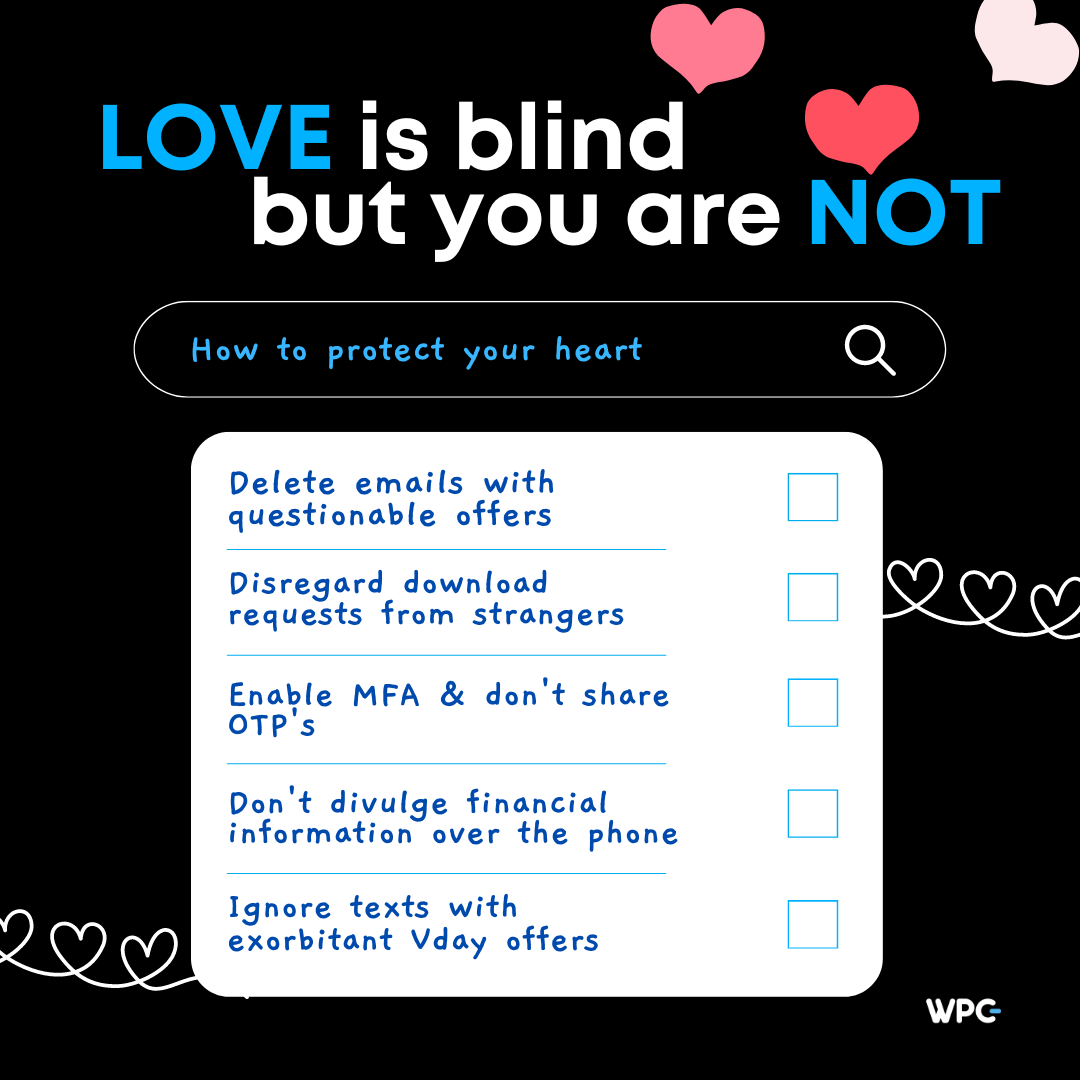Valentine’s Day is known as the day of roses, hearts, lovebirds – and viruses. Cybercriminals use this historic occasion to launch massive attacks using malicious links or attached files. Cybercriminals use many justifications, such as romantic films, and links to websites where you can purchase seamless photographs, gifts, etc., to spread malware across as many computers as they can.
Many people are thinking about chocolates and flowers as Valentine’s Day draws near, but they might not be considering cybersecurity attacks with a romantic theme. However, it’s crucial that you and your company remain vigilant throughout the whole year by monitoring potential cybersecurity risks.
They Say Love Is Blind
There is some truth to it for the number of people who succumb to romantic scams around Valentine’s Day every year.
Cyber dangers on Valentine’s Day are as widespread as diamonds, dining, and gifts. Spammers and con artists alike use February 14th as a yearly opportunity to trick unsuspecting individuals into opening their phishing emails or downloading malicious files. Get ready for some serious heartache if a single person clicks on the incorrectly worded romantic message. Malware has a near-instantaneous ability to infect your whole network and all Internet-connected devices. What a fatal love!
The FTC received a whopping $304 million in losses from romance scams in 2020, which is 50% higher than in 2019. This indicates that these scams are on the rise. Additionally, as a result of the pandemic’s isolation, more and more people are targeted. In this article, you will learn about the types of romance-related cybersecurity hazards that you should be aware of to safeguard yourself or the people you love.
Common Valentines Day Cybersecurity Threats
Vishing, Phishing, and Smishing
Phishing is a technique used by cybercriminals to attempt to persuade you to divulge critical information or carry out a particular action. Additionally, keep an eye out for smishing (phishing via SMS text messages) and vishing (voice phishing). Here are a few examples of romance-specific situations:
- Love notes and E-cards. Even though sending an E-card seems like a kind gesture, it is actually a popular phishing trick. Make sure the romantic e-card you get came from somebody you know and trust. Delete if it’s from a covert admirer! Your computer may have been infected with spyware or ransomware, or an effort may have been made to steal your private information. To persuade you to click the link and give them access to your private information, a threat actor can pretend to be your friend, a family member, or a coworker.
- Shopping deals that are too good to be true. Other typical dangers, such as flower sales, diamond knockoffs, and supper getaway scams, appear in your inbox as false websites. The email’s attachment, if it has one, might contain harmful code. Numerous threat actors are attempting to persuade you that they are offering the greatest price for the item you are considering, but when you click on the link, you unintentionally give them access to your personal data. Check senders, URLs, and other information before using it, and always keep in mind that if a bargain looks too good to be true, it probably is.
- Romantic Malware. Before downloading those Valentine’s Day Facebook profile designs, clip art, or “love tunes” that were just given to your email, give it some thought. Always check the sender’s identity through a different reliable communication channel. In general, it’s advisable to disregard download requests from people if you weren’t anticipating them. Hackers use your good intentions to trick you into downloading malicious software.
Catfishing
A social engineering romance fraud known as “catfishing” involves threat actors identifying their victims online using fictitious identities, images, and other details.
Like other phishing techniques, many threat actors utilize urgency to get you to act immediately or transfer their money without giving the matter serious consideration. This can also be recognized in romance scams by an effort to build an early, intense connection in order to entice victims with an emotional bond.
One well-known instance is the “Tinder Swindler,” a threat actor who spent time conversing with and forging “meaningful connections” with women before using them to steal millions in cash. This narrative recently garnered attention as a result of a Netflix movie about the complex, long-term catfishing scheme used by this threat actor.
Sweet Talk and Dating Apps
It’s critical to keep an eye on the platform’s security in addition to making sure the people you communicate with on dating apps and websites are legitimate.
In 2020, a team of researchers discovered a means to gain access to data about specific Bumble users. Sanjana Sarda, a security analyst, continued to access what should have been private information from Bumble servers even after being locked out, according to Forbes.
This information was as follows:
- If a user’s profile was linked to a social network, their interests
- A broad area that might be pinpointed with sufficient details.
- All of the images that the user had posted to the app.
Make sure to utilize two-factor authentication wherever it’s possible in order to defend against cyberattacks by making sure that each of your accounts has a special, challenging password. Change your password(s) right away if you think your data has been hacked.
Stay Safe From Cybersecurity Threats – All Year Long!
It’s crucial to watch out for warning indicators because romance scams have dramatically increased over the past few years and cyber threats are growing more sophisticated.
Throughout the year, keep your business and family safe with our up-to-date information!
Keep your IT systems protected from cupid’s arrow if your workplace is full of hopeless romantics. To protect your network against Valentine’s Day cyber threats, speak with an MSP like Workplace Connect. Call us at 020-3663-3182 right away.







